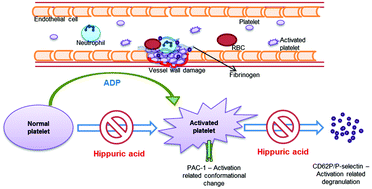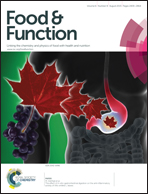The ex vivo antiplatelet activation potential of fruit phenolic metabolite hippuric acid
Abstract
Polyphenol-rich fruit and vegetable intake has been associated with reduction in platelet hyperactivity, a significant contributor to thrombus formation. This study was undertaken to investigate the possible role of hippuric acid, a predominant metabolite of plant cyclic polyols, phenolic acids and polyphenols, in reduction of platelet activation-related thrombogenesis. Fasting blood samples were collected from 13 healthy subjects to analyse the effect of varying concentrations of hippuric acid (100 μM, 200 μM, 500 μM, 1 mM and 2 mM) on activation-dependant platelet surface-marker expression. Procaspase activating compound-1 (PAC-1) and P-selectin/CD62P monoclonal antibodies were used to evaluate platelet activation-related conformational changes and α-granule release respectively using flow cytometry. Platelets were stimulated ex vivo via the P2Y1/P2Y12 – adenosine diphosphate (ADP) pathway of platelet activation. Hippuric acid at a concentration of 1 mM and 2 mM significantly reduced P-selectin/CD62P expression (p = 0.03 and p < 0.001 respectively) induced by ADP. Hippuric acid at 2 mM concentration also inhibited PAC-1 activation-dependant antibody expression (p = 0.03). High ex vivo concentrations of hippuric acid can therefore significantly reduce P-selectin and PAC-1 expression thus reducing platelet activation and clotting potential. However, although up to 11 mM of hippuric acid can be excreted in the urine per day following consumption of fruit, hippuric acid is actively excreted with a recorded Cmax for hippuric acid in human plasma at 250–300 μM. This is lower than the blood concentration of 1–2 mM shown to be bioactive in this research. The contribution of hippuric acid to the protective effects of fruit and vegetable intake against vascular disorders by the pathways measured is therefore low but could be synergistic with lowered doses of antiplatelet drugs and help reduce risk of thrombosis in current antiplatelet drug sensitive populations.


 Please wait while we load your content...
Please wait while we load your content...